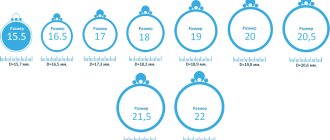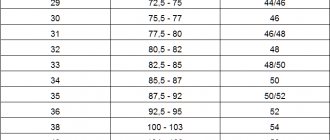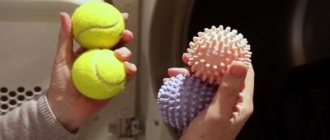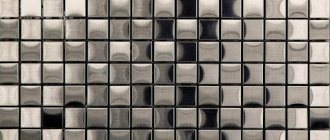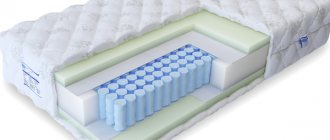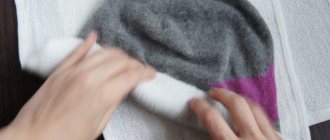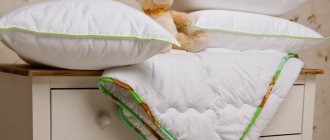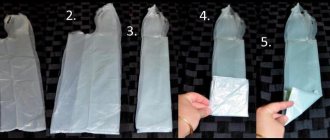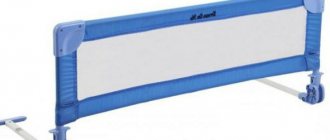How to take head measurements correctly
Expert opinion
Soloviev Pavel Viktorovich
Designer with many years of experience and experience.
When choosing the appropriate headgear size, it is important to correctly measure the diameter of the baby's head. To measure you need to use a measuring tape.
Newborns
The child is placed on a horizontal surface. Measurements are taken when the child is calm. Next, wrap the tape around the frontal or superciliary “bumps” in front, and stretch it to the occipital bump.
Children from 3 to 14 years old
They wrap a measuring tape around the child's head, focusing on the line of the eyebrows, the protruding part of the back of the head and the points above the ears.
Hat size chart for infants and children under 14 years old
You can use ready-made size charts for children of different ages. The main criteria in them are age and height. There are also tables indicating head circumference.
Size chart for newborn hats
| Age | Height | Hat size |
| from 0 to 2 months | 50-54 | 35 |
| 3 months | 56-62 | 40 |
| 6 months | 62-68 | 44 |
| 9 months | 68-74 | 46 |
| 12 months | 74-80 | 47 |
Cap size chart for children under 14 years old
Cap size chart for boys and girls
| Child's age | Size in cm (for boy) | Size in cm (for girls) |
| 0 months | 34-39 | 32-37 |
| 1 month | 37-41 | 35-39 |
| 3 months | 41-45 | 39-43 |
| 6 months | 43-47 | 41-45 |
| 9 months | 46-48 | 43-47 |
| 1 year | 47-49 | 46-48 |
| 1.5 years | 48-50 | 47-49 |
| 2 years | 48-52 | 48-50 |
| 3 years | 49-52 | 49-51 |
| 4 years | 50-53 | 49-52 |
| 5-6 years | 51-54 | 50-53 |
| 7-8 years | 52-55 | 51-53 |
| 9-10 years | 53-56 | 52-54 |
| 11-12 years old | 54-57 | 52-55 |
| 13-14 years old | 54-58 | 52-56 |
Some manufacturers' children's clothing indicates international sizes, which are represented by letters.
| Size | Head circumference |
| XXS | 40-43 |
| XS | 44-46 |
| S | 47-49 |
| M | 50-52 |
| L | 53-55 |
| XL | 56-58 |
When purchasing a hat, you need to know the parameters of your baby by first measuring them. The main thing is to follow the rules when measuring so as not to make mistakes. Based on these parameters, purchase a headdress after reading the size tables.
What to do if there is a foreign marking on the header
The designations on the labels of clothing from Europe and the USA differ from those indicated on Russian items. When purchasing hats in foreign boutiques and online stores, you should convert domestic sizes to foreign ones using a comparison table.
| Head circumference | Letter mark | England | France | USA |
| 47 | – | 5 | 0 | 5 7/8 |
| 49 | S/M | 6 | 1 | 6 1/8 |
| 51 | XXS | 6 1/4 | 2 | 6 |
| 53 | XS | 6 1/2 | 3 | 6 5/8 |
| 55 | S | 6 3/4 | 4 | 6 |
| 57 | M | 7 | 5 | 7 |
We also recommend the article: American clothing sizes in Russian (comparative tables).
Subtleties of sizing
When choosing a headdress it is important
pay attention not only to the design, but also to the quality of tailoring, as well as ease of wearing and washing. Externally, the product may seem nice, but after washing it may lose its shape and color.
Therefore, it is best to buy winter hats, bonnets, panama hats, hats, scarves, and so on from natural fabrics that will not cause your child any discomfort.
- During the first 3 months of a baby’s life, the baby’s head grows very quickly, so you can buy caps for growth.
- By the age of 1, the child's head will increase by 1 centimeter every month.
- from 3 to 10 years, head circumference growth slows down and is approximately 0.5 cm per month.
- If you plan to buy your child an off-season or winter hat, under which you also need to put a cotton one, then in this case you need to buy a hat 1 size larger.
- If the material of a hat, cap, headband or panama hat does not stretch, then it is best to buy a headdress that is sized, not butt-to-fit.
- The material of summer hats and panama hats should be natural, breathable and moisture-absorbing.
- Synthetics should be avoided.
How to choose a hat for newborns
page / Articles / How to choose a hat for newborns
22.07.2018
What kind of hats do babies need?
A hat is a must-have item in the wardrobe of a newborn baby. The head must be protected from the environment because:
- The main outflow of thermal energy occurs through the head, and the baby’s body still does not cope well with thermoregulation;
- The baby's ears are very vulnerable and the slightest breeze can harm them.
So what kind of hat should a young mother buy for a newborn? When choosing a headdress, you should take into account the time of year when the baby was born. If it is spring or early autumn outside, then it is optimal to purchase warm hats made of knitwear and terry. For calm weather, the product can be knitted; if the wind is blowing, then accessories will be needed with ear ties.
In summer, a few cotton bonnets and a fleece hat (for cool evenings) will be enough. For winter, you need to buy a headdress made of denser materials that can protect your child from moisture, wind and cold. Often winter accessories are lined with fleece, fur, or cotton fabric.
Preference should be given to natural materials, because the skin of newborns is very sensitive to synthetics.
Baby hat size
The correct size of headgear is the key to the baby’s well-being and safety. If the product is too small, it will put pressure on the head, causing discomfort and pain to the child.
An accessory that is too large is dangerous - the cap can twist and cover the face, scaring the newborn and making it difficult for him to breathe.
In addition, it will not fit tightly to the body, so it will not be able to reliably protect the ears and head from the wind and cold external environment.
When choosing the right hat size for babies, young mothers can use the following tips:
- for most babies born on time, a hat with a circumference of 35 cm and a length of 13 cm, and clothes of size 50-54 (if the newborn’s height is 49-55 cm) will suit them;
- if the parents or close relatives of the baby (grandparents, uncles/aunts) are very tall, then the child can be big and strong, so it is better to buy clothes in size 62, in the opposite situation, you should buy things in sizes 44-50;
- You can determine the approximate parameters of the baby (size, height, weight) at the last ultrasound examination (performed almost before the birth itself);
- The sizes of children's hats are determined based on measurements of the baby's head circumference (in centimeters).
During the first three months, the child grows rapidly and gains weight. His head grows by about 2 cm every month, so his wardrobe needs to be updated regularly. Further growth slows down and until the baby is one year old, the baby’s head will increase by 0.5-1 cm per month.
A few more requirements for accessories for newborns
When choosing a wardrobe for your little ones, including accessories, you should first of all focus on the quality of the products.
Children's clothes must be well sewn, the seams must be tear-resistant, carefully processed, the fabrics must be well dyed (so that the paints do not fade upon contact with the skin and do not cause irritation).
Here are a few more important requirements for a hat for newborns:
- You should only purchase products made from hypoallergenic natural fabrics or combined ones, but with a high (more than 90%) content of natural fibers;
- you need to make sure that the ties of the accessories are not too tight, and if possible, avoid them altogether;
- the ideal headdress for babies does not have seams, and if it does, it is located on the side and not on the back of the head; responsible manufacturers move the seams of the caps outward; in other models they use “flat seams” technology;
- For the smallest children who are just lying in the cradle, it is better to buy hats without decoration and other unnecessary details - such models are convenient for everyday use, and you can order a more beautiful product for going out;
- children's accessories should be beautiful, match in style and color with the rest of their clothes - this way, from the first days you can teach your child harmony in everything and instill a sense of beauty.
You will find a wide range of hats and accessories for babies in the catalog of the domestic manufacturer Dembohouse, which is known for the high quality of its products and affordable prices.
Differences in size numbering from different manufacturers
Manufacturers of hats use 4 options for size numbering.
- dimensions with intervals equal to 1;
- sizes with even number intervals: 2-4;
- double sizes;
- combinations of sizes: age - size, height - size.
There are manufacturers who meet the needs of consumers; they supply hats with a size stabilizer.
What materials are children's winter hats made from?
In winter, the body is exposed to low temperatures, precipitation and wind. At this time, you need to dress the child in a headdress that protects from the cold, removes moisture and allows air to pass through. It is preferable that it be made from the following materials:
1. Natural wool. When sewing winter hats, natural sheep wool is often used, which retains heat well. To increase its elasticity and wear resistance, acrylic threads are added. This combined material makes warm hats for children and adults.
2. Natural fur. This material is used to sew children's helmets and earflaps. Fluffy pompoms are made from it and used as decoration.
3. Raincoat fabric. The raincoat is waterproof and windproof. Hats made from it protect well from wind and precipitation. However, in warm winters they can be hot. In this case, it is better to choose a combined model made of wool or wool mixture.
When choosing an accessory for the cold season, you need to pay attention to the presence of a lining. In regions that experience record low temperatures in the winter, options with fleece or cotton lining will come in handy.
Tables of hat sizes for children of different ages
It is best to buy hats for children according to size and age, that is, not for growth. Before choosing a hat, panama hat, bonnet or scarf, you should measure the circumference of the child’s head just above the eyebrows.
We look for the result obtained or close to it in the table below and get the Russian size of the head product. Don’t be alarmed if some manufacturer’s size chart starts with a letter rather than a number. It is also necessary to refer to the table, based on the child’s head circumference data.
When choosing a headdress it is important
pay attention not only to the design, but also to the quality of tailoring, as well as ease of wearing and washing. Externally, the product may seem nice, but after washing it may lose its shape and color.
Expert opinion
Soloviev Pavel Viktorovich
Designer with many years of experience and experience.
It is best to buy hats, bonnets, panama hats, hats, scarves, and so on from natural fabrics that will not cause your child any discomfort
You may encounter a situation where the size is indicated not in numeric form, but in letter form. Below are children's hat sizes in letter form.
The peculiarities of the climate of our country are such that both adults and children have to wear a hat most of the year. In some regions, warm hats are put on as early as September and not taken off until the end of spring.
That is why such attention is paid not only to the quality of products or their appearance, but also to the choice of size. A hat that doesn't fit is uncomfortable, cold and unsightly.
Before purchasing a hat, be sure to determine the appropriate size for both you and your children to choose the perfect hat.
What to do if the hat doesn't fit
Knowing at what age head size is 54 and at what age it is 56, you can purchase or sew a hat without calculating the exact parameters of the baby.
If the purchased clothing turns out to be too tight or too big, you can return it to both the online and offline store. The hat is included in the list of goods that can be returned even if the quality is indicative, if they do not fit the parameters, style or color. But the seller has the right to exchange the product for the right one, then a refund is possible only if a suitable hat is not available. To return or exchange an item, three conditions must be met:
- Maintain its integrity.
- Provide a receipt or any alternative document confirming payment.
- Contact the store to request an exchange of goods within 2 weeks from the date of purchase.
The seller may refuse to accept returns of knitted hats, as well as knitted scarves, scarves, mittens, and scarves, since outerwear items made of yarn are included in the list of items that cannot be returned. You can increase it yourself by steaming it from the inside out and stretching it in a warm, damp state. It is easy to re-adjust a piece that is too large when hand-washing hot. And if there is no risk of spoiling the design, it can be done by machine.
A large hat made of wool can be felted, but be extremely careful, otherwise it will shrink by half or even three times. Dip it in boiling water, gradually increasing the temperature until it fits “as if tailored to order.”
© 2022 textiletrend.ru
How to determine your hat size: basic techniques
There are three main criteria for determining the size of a headdress, which are important for both adults and children.
- Tool. The simplest option is to measure your head circumference using a measuring tape. For the most accurate result, the tape should be placed a couple of centimeters above the eyebrows, passed above the ears and closed at the back of the head. The measuring tape can be replaced with a strip of paper. But with such a measuring device you should be careful not to damage it during the measurement process. Non-elastic tape, lace, or fairly thick thread can also be used.
- It is convenient to take measurements in a sitting position. Women should not have voluminous hairstyles or voluminous hair clips on their heads. It is better to hold the baby's head so that the measurement result is correct.
- It is better to entrust this procedure to an outsider. If you measure yourself, you should do it 2-3 times to get the exact size. Some experts advise moving the tape a couple of centimeters up and down to get maximum results on the protruding points.
The more accurately the size of the headdress is determined, the better the hat will fit if you purchase it without trying it on. Since the size of the hat is determined in centimeters, rounding up should be taken into account.
Finally
It is best to try things on before buying, but many beautiful and high-quality children's clothes are sold in online stores. Don't be afraid to buy if you have made the necessary measurements, found out the size you need and indicated it to the seller.
Your attentiveness and our table will make shopping for your child easy and enjoyable.
Adult hat sizes
Determining the size of a headdress for adult men and women is both simple and complex. The size range here is not as large as for children, which makes the process of finding a perfectly fitting hat somewhat easier. But some people do this process for their clients who offer one size products.
Needless to say, such hats, despite their versatility, are not suitable for everyone: for some they are too small, for others they are too big. Therefore, purchasing a headdress with a clear size range makes it possible to get the size as accurately as possible.
IMPORTANT. The size range of hats from different manufacturers may not be the same, so the ideal way to determine whether a hat fits or not is to try on a specific product.
The difficulty in determining the size of an adult hat usually lies in the characteristics of a particular head and the desire to wear a headdress in a certain way. Some people purposefully purchase deliberately large hats that will slide down onto their foreheads and cover their ears and neck.
Others prefer to choose products one size smaller so that the hat fits tightly and does not move.
To get the perfect size, consider the following nuances:
- Synthetic hats stretch over time, but products made from natural materials (cotton, wool or cashmere) may shrink in size.
- An autumn hat can be more spacious, while a winter hat should fit snugly to the head for comfort and warmth.
- The looser the weave of the hat, the greater the likelihood that over time such a headdress will become looser and more stretched.
- A hat with complex patterns and weaves should be spacious so that the design does not stretch, but looks impressive.
- When choosing a size, women should take into account the thickness of their hair, the features of their hairstyle and the presence of hairpins or elastic bands in their hair.
Terminology and types of hats
You may be surprised, but there is a whole “Big Dictionary of Headdresses”, a significant part of which is still in use. Even the seemingly simplest caps or berets have dozens of options and sub-options. It’s difficult to understand all this in detail, and it’s not worth it. Let's just try to highlight the main types of children's hats in order, firstly, to navigate their endless variety, and secondly, to simplify our life when searching for and choosing a hat in an online store.
A cap
The constant leader is the hat, a collective term that in the vast majority of cases means a traditional headdress with a more or less loose cut. It may vary the material, the thickness of the fabric, the design may change slightly (for example, the presence or absence of a pom-pom), but the general features are almost always the same and upon request “boys hat” you will receive a set of items of approximately the same style.
A classic hat without restrictions may contain various prints, patterns, ties, buttons, rhinestones... Of course, a coarse knitted children's hat with a pompom looks a little different than a finely knitted model with patterns and rhinestones, but nevertheless, both options are a hat, aka hat.
Beanie
A beanie hat that fits tightly to the head was once the privilege of working people, athletes, and climbers. But this practical model was quickly appreciated by young people, always hungry for fresh ideas, and then everyone else caught up.
The origin of the term is still debated, ranging between the French "bejaunus" (yellowmouth) and the English "bean" (bean). Despite the simplicity of the design, the beanie is fashionable, fresh and practical, because one of the advantages of the traditional beanie hat is the fact that it takes up extremely little space - no more than a sock, and will fit into any pocket or even pocket.
Baseball cap
Oddly enough, the baseball cap actually has a direct connection with the truly American sport of baseball. In the 50s of the last century, this sports cap with a characteristic visor that protected the players’ eyes from the sun was introduced as an accessory and element of the baseball player’s uniform. Almost immediately, fans acquired similar models, and very quickly the baseball cap ceased to be exclusively a sports headdress.
We recommend reading: Children's snowmobile on gasoline or battery
Everyone liked the design, and when it turned out that various designs could be applied to a baseball cap, a real epidemic began. After all, these caps have become advertising products - along with keychains and pens. Now there are so many options that even a winter insulated baseball cap with natural fur won’t really surprise anyone.
Panama
The straw hat, which gave this headdress its name, is almost no longer associated with it. But, seeing the familiar narrow brim and thick fabric, “Panama hat” (or “Panama hat”, depending on your taste) immediately comes to mind. In fact, what we used to call a Panama hat is the so-called “bucket”, or bucket hat.
The “bucket” was invented by British farmers at the beginning of the 20th century. Then it became popular among fishermen who appreciated the convenience and comfort. As a fashion accessory, the headdress began its journey after the Vietnam War, where it was part of the equipment of American soldiers.
The model’s convenience, comfort and stable demand have led to the fact that the “bucket” Panama hat is invariably present in the catalogs of almost all fashion brands. Well, a children's Panama hat is an accessory that you can't do without on any summer walk.
Determining the size of a hat for a child
Correctly determining the size of a hat for a child is not only important, but also difficult. The problem is not only in fixing the baby while measuring head circumference, but also in the rapid growth of children under 12 years old.
A hat purchased at the beginning of autumn that fits perfectly may already be small by spring, so parents prefer to take this into account and buy a hat slightly “to grow.”
ADVICE. A child's hat should fit perfectly: not slide down over the eyebrows or put pressure on the ears. This is important for newborns, who lie down most of the time, and for growing active babies.
Most manufacturers, to make life easier for parents and other relatives who want to buy a hat for their baby without trying them on, print on the labels not only the size in centimeters, but also the age corresponding to this size. Such tables of approximate hat sizes for different ages can be found on the Internet, but they should be taken into account only when adjusted for the characteristics of a particular baby.
The size of a child’s hat is determined in a manner similar to determining the size of an adult’s hat, i.e. by measuring head circumference.
Subtleties of determining the size of a child’s hat:
Some manufacturers of children's hats indicate only the age of the child in the parameters, which makes it difficult to select a hat without trying it on.
In this case, a table of size grids, which manufacturers rely on, helps to identify the correspondence of basic indicators, such as height and head circumference of the child, with age.
Differences in the numbering of sizes of children's hats from different manufacturers:
Manufacturers use several options for numbering sizes:
1. Dimensions with interval = 1.
2. With even numbers: with interval = 2 or 4.
4. For a combination of size, height or size, age.
With an intermediate value, you need to choose a larger size children's hat.
Important: There are children's hats with a size stabilizer, which is an extremely convenient element for children.
| Size chart for children's hats | |||
| RUS Size in Russian measurement system (centimeters) | |||
| INT International letter size | USA Size in American measurement system | IN Size in inch measurement system (inches) Children's hat size chart |
| RUS Size in Russian measurement system (centimeters) |
Distance from the top of the head to the feet, without shoes.
You need to stand straight with your feet together.
If it is impossible to stand, measurements can be taken lying down from the top of the head to the feet.
Age Person's age (years)Age for which the clothing is designed. Fit depth Planting depth (cm)
Distance from the back of the head to the forehead. Having marked the point to which you plan to move the hat while wearing it, measure from it to the protrusion on the back of the head. Distance from temple to temple (cm)
The tape is placed above the ears and passed on the opposite side of the head.
Size chart for large children's hats
| RUS Size in Russian measurement system (centimeters) |
Warning: The above data are official figures from clothing manufacturers, however, please note that the information is for reference only and does not guarantee absolute accuracy.
Young parents have to face unexpected questions that they had never even thought about before. For example, there was a need to buy a hat for a child, but how to find out the appropriate child size? In general, what should you pay attention to when choosing a miniature cap for a newborn or a thick, insulated knitted hat, or a winter model?
In fact, everything is not that difficult. A special table will help you determine exactly the right hat size for children, the data of which is very easy to navigate. We'll tell you how.
- How to determine the size of a children's hat
- Features of dimensional grids
- Table of hat sizes by age
- How to choose the right hat
Care
If washing is necessary, you must carefully study the information label inside the product. Cotton hats can be washed without any problems at 30 degrees in an automatic washing machine. However, it is worth remembering to choose a short program (30-40 minutes), and the spin speed should be as low as possible. Wool is washed only on a special gentle cycle in cold water.
You cannot spin woolen items in automatic mode at all. It’s a good idea to follow the rule “wash dark with dark, and light with light,” and good laundry detergents won’t hurt either. You shouldn’t overuse laundry detergents; the formula “the more the better” definitely doesn’t work here: excess detergent will affect the color and condition of the headdress. Add exactly the recommended amount of powder or even less than specified.
For good woolen hats, which are not cheap, manufacturers, to play it safe, recommend exclusively dry cleaning as care. Even so, a gentle hand wash in cold water and mild soap won't hurt.
The advantage of synthetic hats, in addition to the low price, is durability. They can be washed at least every day.
How to determine the size of a children's hat
So, to accurately and correctly determine the size of your son or daughter’s headdress, you need to determine the head circumference. This is done like this:
- We take a tailor's centimeter or an ordinary thick thread that does not stretch.
- We measure the circumference of the baby's head along the protruding part of the back of the head, exactly in a circle, from the front, passing over the eyebrows.
- Under no circumstances should we stretch the measuring tape (thread).
- We determine the numerical indicator. If we get an incomplete value, we always round up (for example, 36.2 or 36.8 is better to round to 37).
Knowing how to measure the circumference of a child's head, you will now understand how to determine the size of a suitable hat. Then everything is quite simple - use the appropriate table and purchase the model you like, without doubting whether it will suit your baby.
DIY hat: knitting
While the expectant mother is waiting for the moment of the birth of little happiness, she may well knit a cap for him with her own hands. The dimensions of the finished product can be taken from the table above, taking into account the diameter of the bottom and the depth of the cap. We offer you a very simple hat model, but as a result you will get a cute and warm thing. The size is designed for babies aged 0 to 3 months, you will need 3 knitting needles and 50 g of baby wool yarn:
Cast on 44 loops.
- Knit the first purl and knit row with knit stitches.
- Knit the third row with purl stitches, and the fourth row with knit stitches.
- Continue the given sequence until you have 13 cm of knitting.
- Divide the stitches onto 2 needles, 22 each.
- Using the third knitting needle, knit the stitches on the right and left sides together. This way the hat will be seamless.
- To tie the hat, thread a lace or braid made of thread into the hole in the pattern on both sides of the hat.
Ready!
Features of dimensional grids
Expert opinion
Soloviev Pavel Viktorovich
Designer with many years of experience and experience.
Determining the correct hat size for your child is the main condition for purchasing a headdress. However, you also need to understand the features of the sizing chart so as not to run into other issues.
A child's head, especially in the first year of life, grows very quickly. Don’t be surprised if your recently purchased cap suddenly becomes small – this is absolutely normal. That is why markings change very quickly and “grow” by several centimeters in just a month.
When buying children's hats, make a choice in favor of a larger indicator, then the model will definitely fit.
Better yet, try to purchase in stores where you can try on the product.
Children's pant sizes. table of correspondence
Children's socks size. Table by age
Child's foot size by age. table of correspondence
The sizing charts of modern children's hats are almost identical in all countries of the world. Manufacturers rely on standard indicators - head circumference and height, and often take into account the age of the baby. In general, choosing the right product is not difficult and does not cause confusion.
Tips for choosing
The main criteria for choosing children's hats: material and style. As for fabric or yarn, you should give preference to models made from natural raw materials. For better fit, the presence of elastane fibers is acceptable (no more than 3%). Comfort and safety depend on the composition of the material. It is not recommended to choose synthetic products for a child. In winter, wearing such hats is cold, in summer it is too hot and unsafe.
Of synthetic materials, it is allowed to use fleece as a lining and membrane in the manufacture of the upper part. Such models are suitable for short walks in windy weather.
The style of hats depends on the time of year. For winter cold, it is advisable to choose hats with ear flaps, helmets, and various knitted options. On the eve of summer, hats, panamas, bandanas, and caps are selected.
Knitting hats and bonnets for children under 1 year old
The advantage of knitted hats for babies compared to their sewn counterparts is their elasticity, thanks to which the item can be worn longer, remaining comfortable and performing its functions. Cap This is the easiest headdress to make for a baby. To knit it, it is best to use circular knitting needles for the job. Knitting will be done using the stocking method. The elastic in this product does not knit.
After casting on all the loops, you can start knitting, knitting all the loops in the front way. When the headdress is tied almost to the top of the head, you should begin decreasing the loops. This should be done evenly, there should be fewer and fewer of them in each row. As a result, there should be a single loop left through which the thread is pulled and secured on the wrong side.
Bonnet
The bonnet will provide reliable protection for the child from the winter cold and is well suited for discharge from the maternity hospital.
To knit such a headdress, you need to follow these steps:
- Create a scarf. To do this, knit the initial chain. The loops are cast on taking into account the measurements taken.
- The hosiery method is used for knitting. But you can use another method, alternating rows of air and facial loops. As a result, the product will be elastic and warm.
- At the completion of each row, the knitting must be turned over.
- When the scarf is ready, you should add a hood to it. From the wrong side of the row on which the scarf was knitted, you should pick up loops, and then work in the same way.
- When the required amount of yarn is knitted, the loops must be decreased.
- Upon completion of the work, all that remains is to smooth out the seam.

